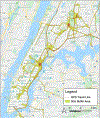Associations of spatial mobility with sexual risk behaviors among young men who have sex with men in New York City: A global positioning system (GPS) study
- PMID: 32473485
- PMCID: PMC7373175
- DOI: 10.1016/j.socscimed.2020.113060
Associations of spatial mobility with sexual risk behaviors among young men who have sex with men in New York City: A global positioning system (GPS) study
Abstract
Spatial contexts and spatial mobility are important factors of the HIV epidemic and sexually transmitted infections. Using global positioning system (GPS) devices, we examined the associations of objectively measured spatial mobility with sexual risk behaviors among gay, bisexual and other men who have sex with men (MSM) in New York City. This observational study included a subgroup of 253 HIV-negative MSM from the Project 18 Cohort Study, who participated in the GPS monitoring sub-study. Spatial mobility was measured as (1) distance traveled and (2) activity space size defined as daily path area during 2-week of GPS tracking. We examined the associations of these measures with numbers of male sexual partners and condomless anal intercourse (CAI) acts during last six months using quasi-Poisson models, adjusting for socio-demographics. Results demonstrated that spatial mobility was positively associated with sexual risk behaviors, for example, with CAI (incidence rate ratio [IRR] = 1.01 for a 10 km increase in distance traveled and IRR = 1.04 for a 1 km2 increase in 50 m-buffer activity space size). Our findings may enhance the understanding of spatial contexts of HIV risk. Future studies should be conducted to examine the mechanisms for the associations between spatial mobility behaviors with sexual risk behaviors as well as the influence of neighborhood characteristics in various neighborhood contexts, which may guide the place-based HIV prevention services.
Keywords: Global positioning system (GPS); HIV prevention; Men who have sex with men (MSM); Mobility; Sexual behavior; Spatial analysis.
Copyright © 2020 Elsevier Ltd. All rights reserved.
Figures
References
-
- AIDALA A, CROSS JE, STALL R, HARRE D & SUMARTOJO E 2005. Housing status and HIV risk behaviors: implications for prevention and policy. AIDS Behav, 9, 251–65. - PubMed
-
- AL-AJLOUNI YA, PARK SH, SCHNEIDER JA, GOEDEL WC, HAMBRICK HR, HICKSON DA, CANTOR MN & DUNCAN DT 2018a. Partner meeting venue typology and sexual risk behaviors among French men who have sex with men. International Journal of STD & AIDS, 29, 1282–1288. - PubMed
-
- AL-AJLOUNI YA, PARK SH, SCHNEIDER JA, GOEDEL WC, RHODES HAMBRICK H, HICKSON DA, CANTOR MN & DUNCAN DT 2018b. Partner meeting venue typology and sexual risk behaviors among French men who have sex with men. International Journal of STD & AIDS, 29, 1282–1288. - PubMed
-
- BELOT M & ERMISCH J 2009. Friendship ties and geographical mobility: evidence from Great Britain. Journal of the Royal Statistical Society Series a-Statistics in Society, 172, 427–442.
Publication types
MeSH terms
Grants and funding
LinkOut - more resources
Full Text Sources
Medical


